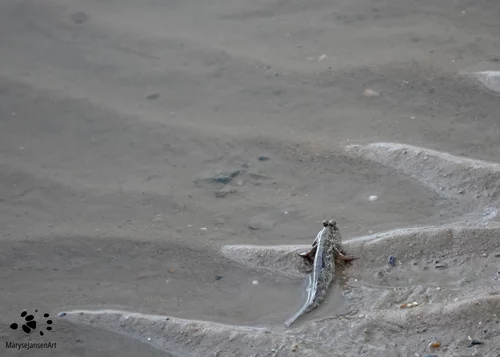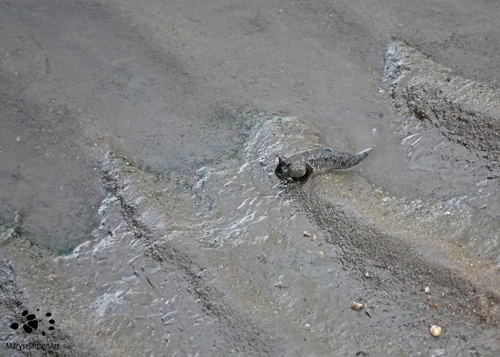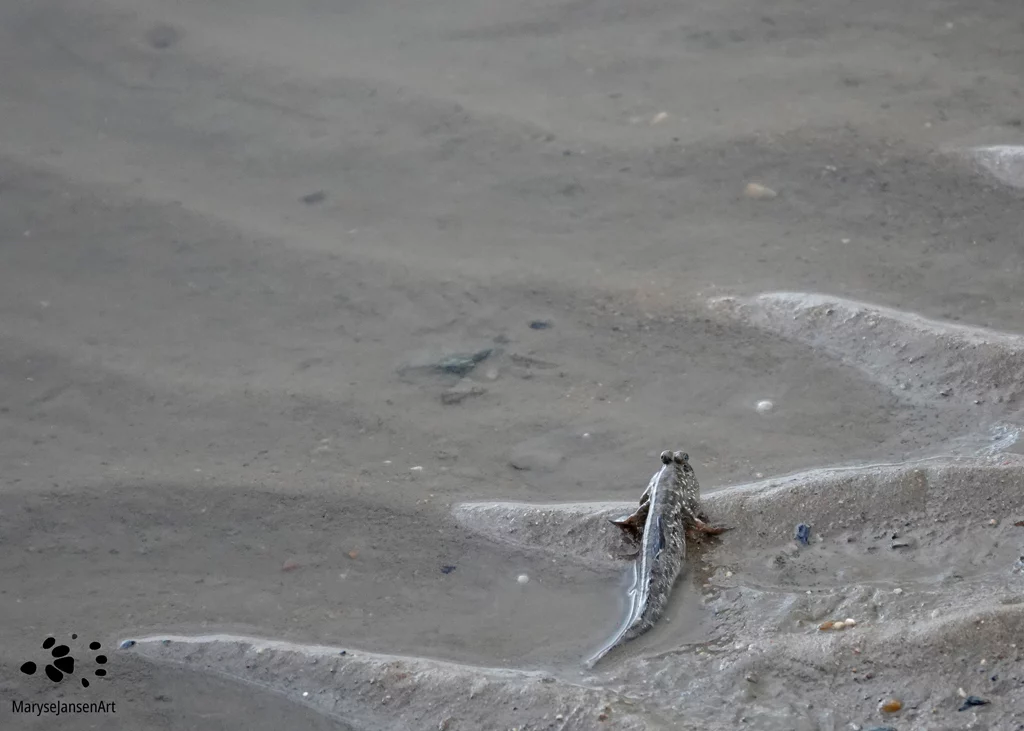Wildlife Photography with marysejansenart
Exploring life on the mudflats – the kingdom of wading birds, crabs and mudskippers

Mudflats stretch out before me, the tide is as far out as it goes and it’s a long way! The grey-brown mud doesn’t look exactly appealing but I quickly discover there is a lot more to it then what you would think at first sight!
Table of Contents
Migratory Wading Birds
When I look out over the mudflats a bit longer I begin to spot some birds: Bar-tailed Godwits. Their dappled brown plumage gives them good camouflage on the mud, which is why it takes a while to see them. The same applies to a Whimbrel as well as the little Sandpiper that is running around frantically.
These species are all migratory birds. They breed in the northern hemisphere, and when it gets cold there, they fly down thousands of kilometres to the southern hemisphere where food is abundant in this season. They eat mulloscs, worms and other small creatures. I spot the Whimbrel feasting on a small crab.
Crabs
From what I can see there are plenty of small crabs around. There’s a little colony of Orange-clawed Fiddler Crabs. They are a joy to watch! I spotted one recently during a walk in the mangroves but here I can see several, including males and females. The males are very busy waving their enlarged claw around, marking their territory and hoping to entice one of the ladies to descend in their burrows. I see also many other species of small crabs, including a black beauty dappled with teal coloured blotches and bright purple pincers!
A bit further away from me it looks like the mud is dotted with large black pebbles. But suddenly one moves! I peer through my zoom lens and I discover that these are all crabs too! They are a lot larger then the little Fiddler Crabs and clearly not worried about falling prey to the Whimbrels. They sit there quite comfortably, whereas the smaller crabs are always quick to disappear into their burrows at the slightest disturbance!
Mudskippers
Another small movement catches my eye. It comes from an animal that is very well camouflaged on this muddy background. It’s a mudskipper! Mudskippers are very interesting creatures. They are an amphibious fish, thus able to live in and outside of the water! They live on the mudflats in the highest intertidal zone in the northern half of Australia. During low tide, they can be seen on the mudflats.
Mudskippers look much like a fish, with two noticeable distinguishing features. Their eyes and their side pectoral fins. Their large eyes protrude from the top of their flat head and look a bit like the eyes of a frog. They can move them independently and see almost 360 degrees around them! Their eyes are also retractable. When they blink, they retract their eyes in a water-filled chamber to keep them moist.
Their side pectoral fins are well developed and located more forward and under their body then in other fish. Thanks to this they are able to use these fins as legs and move around on the mudflats during low tide. They move both fins simultaneously which gives the impression of skipping.

How do mudskippers breathe?
Mudskippers have several ways of breathing. Like fish, they have gills that help them breathe when under water. When out on the mud, they can carry water in their gill chambers which allows them to keep breathing with their gills for some time. When these chambers are full with water they look like blown up cheeks, again a bit like in a frog!
Their other way of breathing resembles that of an amphibian: they can breathe through their skin! It is important in this process that they keep themselves moist. This is why they need to live in humid environments with easy access to water.
How do mudskippers spend their time in the water and on land?
To ensure easy access to water during low tide, the mudskippers dig burrows in which water will be trapped as the tide goes out. The burrow also serves as a hide out for when there are predators about and as a place to lay their eggs. During high tide, these animals often retreat into their burrows.
Their time on land is when they are most active. This is when they feed. They hunt for small animals such as insects, worms and small crustaceans. Indeed, another animal with an appetite for crabs! They also interact with each other to protect their territory and to attract a mate.
What do we know about the reproduction of mudskippers?
Mating occurs in the male’s burrow. After the eggs have been laid and fertilized, the male chases the female out of the burrow and takes on the task of looking after the eggs. It is not an easy task, as he needs to make sure that there is enough air in the egg chamber at all times. He does so by taking gulps of air from the surface and then depositing that in the egg chamber. At the same time he needs to defend the burrow from predators. Little hatchlings are released during high tide and become part of the plankton. The lucky ones that survive and develop into adulthood will be a small number.
Reading about the reproductive process of the mudskipper questions may arise, such as: ‘How do the eggs get fertilized?’ Or: ‘How do the hatchlings escape from the burrow?’ A lot of these things are still unknown and interesting territory for scientists to explore.
Join me on my walk in the in the latest episode of ‘Come of a walk in the Australian Bush’ and meet the mudskippers, as well as the crabs and the birds that I described above.
If you are interested in purchasing the featured image ‘Mudskipper on the Lookout’ or would like to see what it looks like on the various products, please head to my shop. For ‘Mudskipper’ click here and check out images of crabs, birds and other marine life in my Australian Marine Life Gallery.


